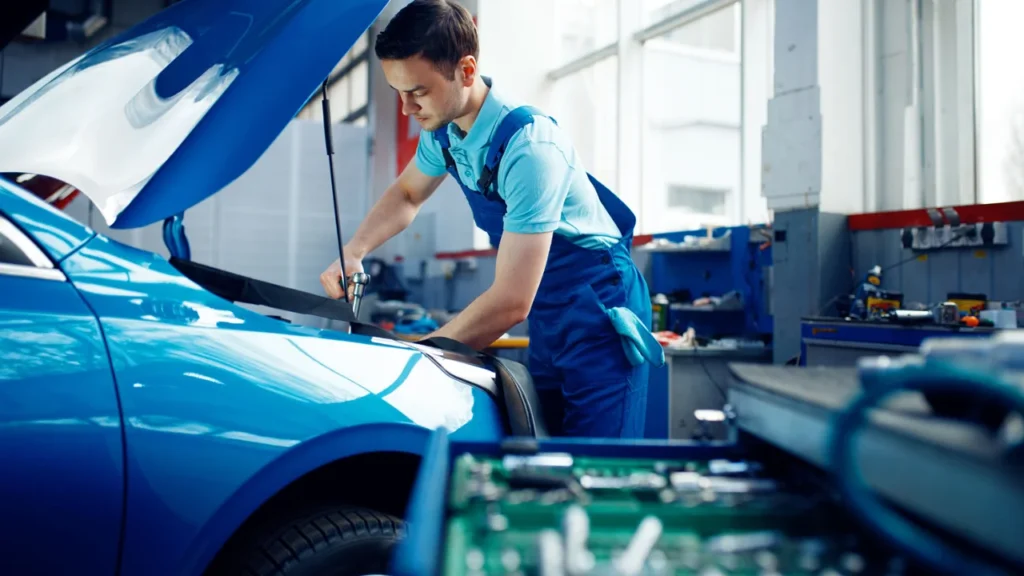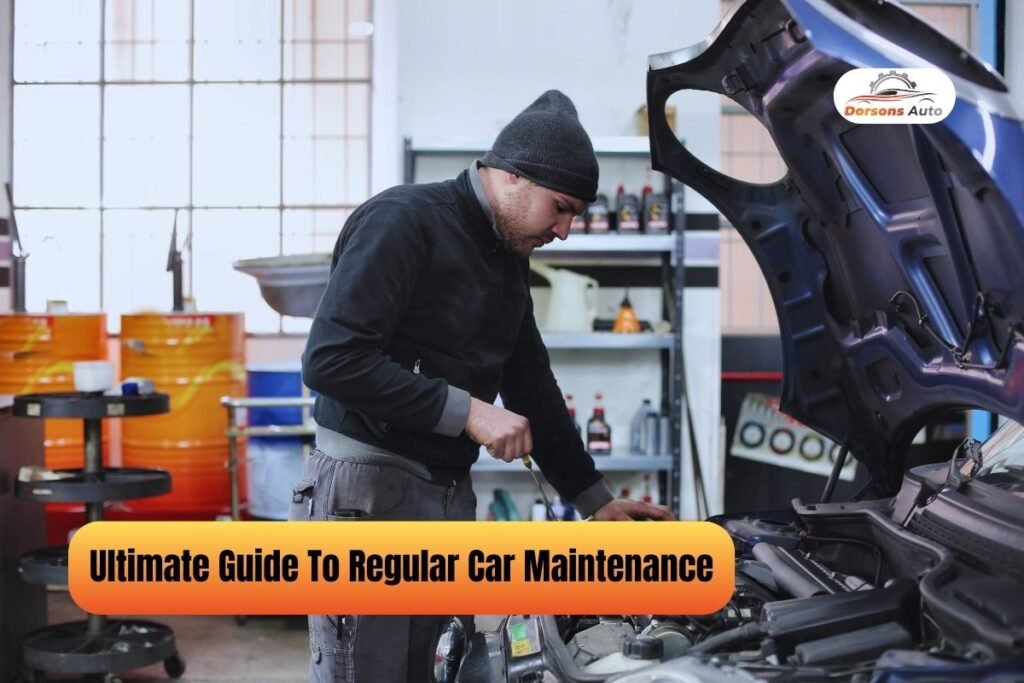Maintaining a car regularly prevents expensive repairs and contributes to a smooth driving experience. When something is wrong, your car may signal. Even erratic or ambiguous symptoms could point to the start of a serious issue with your vehicle.
Although it takes time and money, maintaining your car is an investment that pays off. After a roadside breakdown, proper maintenance can save expensive repair costs. You may efficiently plan and budget by obtaining maintenance costs in your area with ease.
Here’s an Ultimate Guide To Regular Car Maintenance.
How Frequently Should You Get an Inspection for Your Car?
The owner’s manual can help you become acquainted with your vehicle, which is the first step. You can find these useful handbooks in your car’s glove box or online at the manufacturer’s website. Take some time to briefly read the guidebook, making notes of any puzzling passages so you can review them later.
From the inside to the underbelly, every element of your car will be covered by this guidebook. It can make driving more fun to know where all the practical features of your car are, such as hidden outlets, extra compartments, and other amenities. You can find detailed maintenance instructions for your specific car in the handbook as well.
Usually, the recommendations include a schedule, a maintenance checklist, and important details about car care. This contains information about recommended oil types when to change belts and filters, and safety measures to take when doing maintenance checks. Investigate any confusing maintenance components. The schedule specifies when particular parts should be replaced and when your car should be inspected by a mechanic.
Follow the specified dates in your owner’s manual to ensure the long-term functionality of your vehicle. For example, replacing your car’s brake pads at 50,000 miles is an important milestone. To guarantee preventive and efficient maintenance, pay particular attention to this schedule.
1. Conduct Routine Inspections
Quick and routine auto inspections can help you identify possible issues before they become dangerous or expensive. Nobody wants to have to pay large repair bills that were simply preventable. With experience, these brief checks—which can take as little as one or two minutes—become more automatic and can identify issues early on.

Key weekly checks have:
- Check that your turn signals, taillights, and headlights are operating following the law.
- Look for any rust indications on the hood and the vehicle.
- Examine the battery for corrosion, dirt, frayed cables, and cracks in the casing.
- Visually verify that there are no leaks by checking the fluid levels in clear containers.
- Turning on and off your wipers will test them.
If anything unusual is found during these inspections, you should make an appointment with your mechanic right away.
2. Fix Certain Problems Instantly
Some problems need to be resolved right away since they could endanger your safety, damage your engine, or get you a ticket. The following problems should be taken care of right away; if in doubt, consult your mechanic.
Check Engine Light:
Issues with the electronic control system are indicated by the check engine light. Ignoring it could put your safety at risk and cause engine issues. Make an appointment with a mechanic if the light persists, particularly if it is flashing.
Tire Pressure:
If the tire pressure light illuminates, use a gauge to check and adjust the tire pressure according to the instructions on the label on the driver’s side door. Sustaining appropriate tire pressure reduces fuel consumption and averts blowouts.
Turn Signals, Taillights, And Headlights:
To guarantee safety and prevent tickets, keep your turn signals, taillights, and headlights in working order. Replace any broken lights as soon as possible to maintain vision while driving.
Wiper Blades:
Visibility is hampered by defective wiper blades, particularly in the rain. To guarantee safe driving conditions, replace them if they are outdated or malfunctioning.
3. Check And Fill Your Car’s Fluids Monthly
To make sure your automobile is operating properly, check the fluids once a month. Check and replenish the following fluids regularly:

Engine Lubricant:
- Every month, use the dipstick to check the oil level.
- Make sure the dipstick’s oil level is between the two dots at the end.
- Add the appropriate oil type or get an oil change from your professional if it’s below the lower dot.
Antifreeze/coolant:
- Find the semi-translucent container with the “full” and “low” markings next to the engine.
- Between the designated lines is where the coolant should be.
- Sludgy or brown coolant should be replaced; ask your professional about this.
Fluid for windshield wipers:
Regularly check the wiper fluid levels.
Find the bottle of wiper fluid underneath the hood.
As directed on the bottle, add windshield wiper fluid if the levels are below the minimum line.
Maintaining these fluids regularly guarantees top car performance and guards against potential damage. To find out more detailed information on the fluids your car uses, consult your owner’s manual.
4. Inspect Your Tires Every Month
Check tires once a month to maintain road safety and reduce hazards. As part of your monthly tire care regimen, incorporate the following steps:
Tire Age:
To find out the manufacturing date of each tire, look for the DOT mark on it.
Tires should be replaced six to ten years after the date of manufacture, damage or tread condition notwithstanding.
Tire Pressure:
To avoid low tire pressure, top up your tires once a month.
Every month, tires lose about one pound per square inch of air, and during colder months, this loss increases.
Regularly check and top off tire pressure to stay ahead of problems.
Tire Treads:
Use the penny test to determine the depth of the tire tread.
Try sticking a dime, Lincoln’s head facing down, into the tread. If you can see the top of the head, the tire has to be replaced.
It’s very important to have enough tread depth when driving in the rain or snow.
Tire Damage:
Examine each tire visually for any cracks, cuts, or punctures.
See your mechanic for guidance on the appropriate course of action if any damage is noticed.

Rotate Your Tires Once or Twice a Year
Have your tires rotated once or twice a year to ensure even wear. To find out if the wheels and tires on your car need to be rotated, consult the owner’s manual. Ignoring this maintenance can cause uneven tires, which raises the chance of hydroplaning and losing grip while making driving jerky and unsteady.
Routine tire care promotes overall road safety by reducing the risk of blowouts and sliding in bad weather. If you’re unsure about the age or condition of your tires, get expert advice.
5. Change The Filter And Engine Oil Once or Twice a Year
Replace the engine oil and filter once or twice a year to extend the life of your car’s engine. Think of oil as the lifeblood of your car since it keeps the engine running smoothly, lowers friction, and guards against damage. For precise mileage and time guidelines, such as every 5,000 miles or every six months, consult your owner’s manual. The change interval is affected by various factors such as driving conditions, frequency, and type of oil used. The sooner the oil is changed, the better, so call a mechanic.
Change The Air Filter in Your Engine
Moreover, change the engine air filter regularly; this should be done every 15,000 to 20,000 miles. Adapt this interval to your driving conditions and area. If the location is dustier, you might want to replace it once or twice a year; in cleaner surroundings, you might be able to wait three years. Determining the ideal replacement frequency is made easier by inspecting the filter at every oil change.
Inspect Belts and Hoses
checking the belts and hoses in your car beyond standard maintenance. Verify that the hoses are securely attached and free of bulges or breaks. A vital timing belt is found in many cars; if it begins to exhibit indications of wear, such as cracking, missing material, or glazing, it must be replaced right once to ensure optimal engine operation. The general health of the car is improved by routine examinations of these parts.

6. Alerts Notification Requires Car Maintenance Done
Even a well-kept vehicle may exhibit warning indications before a thorough examination, indicating the need for unplanned maintenance. The “check engine” light is a typical signal, although other problems also require immediate attention:
- Braking: Take prompt action to fix any “soft” brake pedal or strange noises like squeaking or scraping, as these problems can be dangerous.
- Absence of acceleration: A vehicle’s performance changes could be a sign that the engine needs to be tuned.
- Vibration: To identify any problems, seek the advice of a mechanic if your vehicle shakes when it starts up, turns, or stops.
- Stalling or having trouble starting: If your car stalls or has trouble starting, get expert help.
- Fuel efficiency: Variations in gas mileage may indicate issues such as malfunctioning sensors or fuel injector leaks.
- Wheel Alignment: If you leave your car’s alignment out of commission, it may cause severe damage to the axles. Misalignment is indicated by symptoms like swerving to one side or rattling at high speeds. See your mechanic for an alignment check to guarantee correct alignment, which will minimize uneven tire wear and enhance handling and gas efficiency.
- Exterior: Keep the outside of your automobile clean to avoid rust and damage. At least two washes a year should be your goal; if you frequently drive on muddy or unclean roads, you should aim for more frequent cleaning. To keep your automobile looking new, choose to wash it yourself or use a car wash service.
- Shifting: In automatic transmissions, abnormal shifts or lurches may indicate a problem with the transmission.
Keep an eye out for any less evident or irregular symptoms of an issue as well. If you notice any strange driving behavior in your automobile, follow your gut and get advice from a mechanic. If there are performance issues with your car, get in touch with a reliable mechanic or your neighborhood dealership for a comprehensive assessment and diagnosis.
Frequently Asked Questions FAQs
What routine maintenance is required for a car?
Regular car maintenance includes a tune-up and the replacement of consumable items such as motor oil, radiator coolant, brake fluid, power steering fluid, wiper blades, and brake pads.
How do you know when to do routine maintenance on your vehicle?
Check your vehicle’s owner’s manual to find the recommended schedule for car maintenance services. Basic maintenance involves checking or replacing parts like spark plugs, wires, fluids, and serpentine belts. Scheduling through your dealer is often recommended.
Why is daily maintenance required for a vehicle?
Daily maintenance increases safety on the road. It’s crucial to take preventive measures on a deserted road to avoid incidents. Regular checks include inspecting the car for underlying problems like a broken hose, loose belts, or a faulty battery.
The Bottom Line
It is crucial to have regular auto maintenance done to reduce major dangers and extend the life of the vehicle. Being proactive guarantees the safety and best possible performance, from routine maintenance like checking the tire pressure to attending to warning indicators like the “check engine” light. Frequent maintenance procedures, such as wheel alignment and exterior cleaning, increase overall performance by lowering wear and improving fuel economy.
Read More:
Top 5 Pickup Trucks 2024 Price, Features & Review
The Top 5 Hottest Electric Cars of 2024

